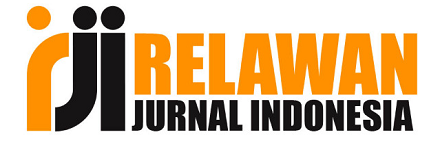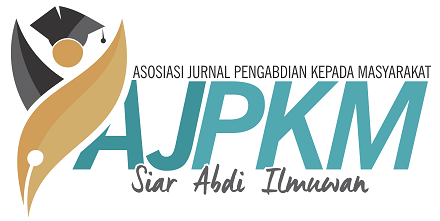Gambaran pengetahuan dan penerapan personal hygiene siswa dalam upaya mencegah infeksi soil transmitted helminth (STH)
DOI:
https://doi.org/10.33474/jipemas.v4i1.9105Keywords:
knowledge, student, STH, personal hygieneAbstract
Cases of intestinal worms or often referred to as neglected tropical diseases are a global problem that occurs in society. Groups of school-age children are more susceptible to being infected by parasitic worms transmitted through the soil (Soil-Transmitted Helminth). The dangers of STH infection in children are impaired nutrient absorption, malnutrition, weight loss, and cognitive decline. The problem at SDN Karangkembang is that student activities are closely related to the risk factors of STH transmission, namely, playing sand without footwear, not washing hands, hawker vendors around the school who are less hygienic. Also, there are no adequate handwashing facilities in schools. Based on these problems, the Faculty of Veterinary Medicine, UB initiated a community service program namely worm socialization and prevention efforts through the application of personal hygiene. The results obtained during this community service activity are that 83% of students have carried out the practice of cleanliness very well, then 9% of students have carried out well, 4% of students carry out adequately and 4% of students are still lacking. This community service activity can coordinate all students, teachers, and parents to commit to always apply personal hygiene to improve the quality of life both at school and at home.
References
Albonico, M., Allen, H., Chitsulo, L., Engels, D., Gabrielli, A. F., & Savioli, L. (2008). Controlling soil-transmitted helminthiasis in pre-school-age children through preventive chemotherapy. PLoS Neglected Tropical Diseases, 2(3). https://doi.org/10.1371/journal.pntd.0000126
Bethony, J., Brooker, S., Albonico, M., Geiger, S. M., Loukas, A., Diemert, D., & Hotez, P. J. (2006). Soil-transmitted helminth infections: ascariasis, trichuriasis, and hookworm. Lancet, 367(9521), 1521–1532. https://doi.org/10.1016/S0140-6736(06)68653-4
Ghanim, M., Dash, N., Abdullah, B., Issa, H., Albarazi, R., & Al Saheli, Z. (2016). Knowledge and Practice of Personal Hygiene among Primary School Students in Sharjah-UAE. Journal of Health Science, 6(5), 67–73. https://doi.org/10.5923/j.health.20160605.01
Hardianti, U., Urip, & Jiwintarum, Y. (2018). Prevalensi Kecacingan Golongan Sth (Soil Transmitted Helminth) Pada Anak Usia 3-6 Tahun Pasca Gempa Bumi Di Desa Sembalun Kabupaten Lombok Timur. Jurnal Analis Medika Bio Sains, 5(2).
Islamudin, R., Suwandono, A., Dian Saraswati, L., & Kusuma Putri, R. (2018). The Association Between Soil Transmitted Helminth Infections with Nutritional Status in Children (A Cross Sectional Study in Elementary School, Candi Village, Semarang District, Central Java Province, Indonesia). KnE Life Sciences, 4(4), 288. https://doi.org/10.18502/kls.v4i4.2288
Jia, T. W., Melville, S., Utzinger, J., King, C. H., & Zhou, X. N. (2012). Soil-transmitted helminth reinfection after drug treatment: A systematic review and meta-analysis. PLoS Neglected Tropical Diseases, 6(5). https://doi.org/10.1371/journal.pntd.0001621
Kemendikbud. (2019). Sekolah sehat berkarakter. 1–14.
Khatoon, R., Sachan, B., Khan, M., & Srivastava, J. (2017). Impact of school health education program on personal hygiene among school children of Lucknow district. Journal of Family Medicine and Primary Care, 6(1), 97. https://doi.org/10.4103/2249-4863.214973
Murni, P. H. S., Lubis, M., & Fujiati, I. I. (2018). Hubungan Infeksi Soil Transmitted Helminths dengan Kemampuan Kognitif, Status Nutrisi, dan Prestasi Belajar pada Anak Sekolah Dasar di Desa Sikapas Kabupaten Mandailing Natal. Sari Pediatri, 19(5), 279. https://doi.org/10.14238/sp19.5.2018.279-83
Novianty, S., Dimyati, Y., Pasaribu, S., & Pasaribu, A. P. (2018). Risk Factors for Soil-Transmitted Helminthiasis in Preschool Children Living in Farmland, North Sumatera, Indonesia. Journal of Tropical Medicine, 2018. https://doi.org/10.1155/2018/6706413
Pasaribu, A. P., Alam, A., Sembiring, K., Pasaribu, S., & Setiabudi, D. (2019). Prevalence and risk factors of soil-transmitted helminthiasis among school children living in an agricultural area of North Sumatera, Indonesia. BMC Public Health, 19(1), 1–8. https://doi.org/10.1186/s12889-019-7397-6
Sarkar, M. (2013). Personal hygiene among primary school children living in a slum of Kolkata, India. Journal of Preventive Medicine and Hygiene, 54(3), 153–158. https://doi.org/10.15167/2421-4248/jpmh2013.54.3.401
Suryanto, I. W. (2018). Penerapan Personal Hygiene Bagi Anak Sekolah Dasar , Khususnya Mencuci Tangan Dan Gosok Gigi. June 2016, 0–30.
WHO. (2012). Soil-transmitted helminthiases: eliminating soil-transmitted helminthiases as a public health problem in children: progress report 2001-2010 and strategic plan 2011-2020. WHO Library Cataloguing-in-Publication Data., 186–215. https://doi.org/10.1007/978-3-642-70841-1_5
WHO. (2017). WHO Guideline: preventive chemotherapy to control soil-transmitted helminth infections in at-risk population groups. World Health Organization.
Downloads
Published
How to Cite
Issue
Section
License
.









